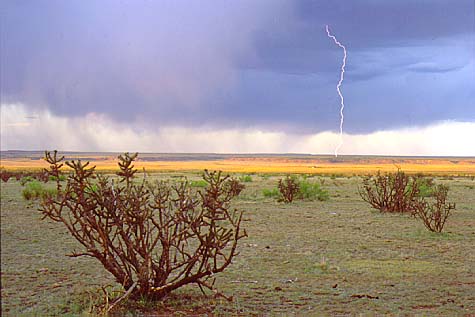
image © Robert Luis
Chavez
Desert Angel...
Aspring storm about 40 miles
south of Santa Rosa New Mexico
TECHNICAL STUFF
Platforms
Since I'm usually making very long exposures a good heavy tripod or
platform is important if I want the foreground to be sharp. A tripod
is not always the most practical thing for lightning photography, so
for safety and flexibility I use a car window mount. The mounts are
primarily made for spotting scopes, but work just as well with still
or video cameras. Another technique I use is simply hand-holding the
camera, even while driving. Hand holding is less predictable, but I've
captured a few winning images this way, see "Electric
Avenue" and "Dance Of
The Sisters".
Exposure
The shortest exposure I'll make is usually thirty
seconds. Sure it's possible to wait and click your shutter right when you see
a strike and capture it on film, but I've found that it's more predictable to
wait till the light is low enough to make long exposures. Remember the longer
the exposure the more strikes you can capture on a single frame of film. With
a slow film you can start to get at least a thirty second exposure about ten
minutes after sunset. When it's completely dark you can make exposures as long
as you want, though with some limitations: very close strikes or long exposures
require smaller apertures to prevent overexposure. Somewhere between f/8 and
f/22 usually works for me, you'll just have to experiment.
Film
Slower is better whatever brand you prefer, you'll get longer exposures
(see above) and tighter grain. All films have some sort of color shift when
used for long exposures, Velvia for example has a green shift after ten minutes
or so, Kodachrome has a magenta shift with even shorter exposures. The most
neutral film I've tried so far is Ektachrome EPN. I haven't figured out what
kind of shift EPN has yet, even at exposures nearing one hour it remains very
neutral.
Digital
So far most digital cameras, even the new and expensive ones, have some
problem with a noisy signal when you start making exposures longer than
a few minutes or even a few seconds, it looks a little like underexposed
film. Battery power is another issue because digital cameras require
more power, so be prepared to swap out battery packs if you want to
shoot all night or make moonlight exposures. In short, there is nothing
that matches the ease of shooting night pictures on film, on an all
or mostly mechanical camera. All of that is changing as we speak, and
if you are shooting digital, by all means shoot night and lightning
pictures. Just be aware of the limitations of digital when your exposures
are in the range of minutes or hours long.
Where to Point the Camera?
The saying goes "lightning never strikes the same place twice", that
may be true, but for photogrphy it is still easy to predict the general
area of the next strike by the last ones. The smaller the storm the
easier it is to predict where the lightning will be. If there's a column
of rain falling from the cloud that's usually the most active area of
lightning, however when lightning strikes outside of the rain, that
can be very photogenic. Enjoy the pictures and happy storm hunting to
you. Robert Luis Chavez